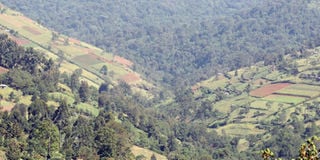11,000 hectares to be conserved in Maasai Mau forest

A section of Mau Forest. Narok County Assembly members have demanded that settlers in the Maasai Mau forest be evicted. PHOTO|FILE.
What you need to know:
- Kenya Forest Service deputy director Esau Omolo told the launch ceremony at Nyangores Forest at the weekend that the initiative was aimed at to sensitising residents around the water tower on the need to control and coordinate conservation efforts to increase forest cover.
- Sections to be conserved are Nyangores, Nairotia and Olenguruone forest blocks.
A plan to rehabilitate and conserve 11,000 hectares in Maasai Mau Forest has been launched.
The new plan, which will involve communities living next to the forest, seeks to restore the Transmara Forest Block.
Kenya Forest Service deputy director Esau Omolo told the launch ceremony at Nyangores Forest at the weekend that the initiative was aimed at to sensitising residents around the water tower on the need to control and coordinate conservation efforts to increase forest cover.
Mr Omolo said in the new programme, the community would be allowed to fell trees ready for harvesting.
Sections to be conserved are Nyangores, Nairotia and Olenguruone forest blocks.
The programme, spearheaded by the Community-Based Integrated Forest Resource Conservation Management (COMIFORM), follows another by Community-Based Integrated Forest Resource Conservation Management which involved planting of bamboo trees by farmers to restore forest cover.
More than 40,000 hectares that had been destroyed in the Mau forest has been rehabilitated in the last three years.
Some 10,000 people have voluntarily surrendered their title deeds to pave way for conservation of the Mau forest and plans underway in profiling a list of individuals who had genuine title deeds so as to facilitate compensation by the government.
The deputy director said that the three forest blocks have been encroached and a participatory approach involving the community will assist in rehabilitating the forest.
“The management plans will enable the community to enter the forest cut down aged or ripe tree ready for harvesting and replant them but with guidance of the KWS officers,” said Mr Omolo.
He called on all the stakeholders to support the government in matters of conservation.
Maasai Mau forest is Kenya’s biggest water tower whose destruction has threatened the survival of 12 rivers flowing into Lake Victoria, Lake Nakuru and serving Maasai Mara and Serengeti game reserves eco-systems..
The illegal felling of trees at the forest is also a threat to agriculture, tourism and energy sectors.
The government has been facing stiff opposition from some Rift Valley leaders over its efforts to conserve the 400,000 hectares Mau Forest Complex.
Hundreds of squatters were removed from the forest in the first and second phase of the restoration efforts.




